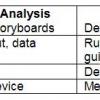|
|
Creating Great User Experiences: Tips and Techniques
Slideshow
Many software people look at creating great user experiences as a black art, something to guess at and hope for the best. It doesn't have to be that way! Jennifer Fraser explores the key ingredients for great user experience (UX) designs and shares the techniques she employs early-and often-during development. Find out how Jennifer fosters communications with users and devs, and works pro-actively to ensure true collaboration among UX designers and the rest of the team. Whether your team employs a formal agile methodology or not, Jennifer asserts that you need an iterative and incremental approach for creating great UX experiences. She shares her toolkit of communication techniques-blue-sky brainstorming sessions, structured conversation, and more-to use with different personality types and describes which types may approach decisions objectively versus empathetically.
|
Jennifer Fraser, Macadamian
|
|
|
Adding Good User Experience Practices into Agile Development Whose job is it to ensure that the user has a good experience with a new application? As agile processes are taught today, the user experience (UX) design practice is usually left out or at best described as an optional team role. However, the companies that build useful, usable, and desirable software know that UX is baked into the whole development process. Jeff Patton describes what user experience design is and isn’t, and how every person on the team has something to contribute. Hear concrete examples of how companies have adapted their UX practice to work well in an agile context and, along the way, discovered innovative UX practices that work better in agile contexts. Jeff explores pragmatic personas, guerrilla user research, design sketching, lightweight prototyping, and concept testing. Leave with valuable tips for adding UX practices and thinking to your agile process to help you get good user experience.
|
Jeff Patton, Jeff Patton & Associates
|
|
|
Arming Advertisers versus Users: Social Media Platforms at Odds` Twitter and App.net both made headlines recently by taking completely different approaches to reach the same goal: dominance in the world of social media.
|
|
 |
True Performance: Moving Beyond Basic Load Testing Basic load testing is valuable, but it's important to move past simplistic efforts. Here are some ways to gain more accurate metrics from your load tests.
|
|
|
|
Load Test Your Website Before Your Customers Do When you release a website or web application, it’s going to face a lot of very public load testing. If it performs poorly, there’s a good chance that you’re going to lose a lot of customers. Colin Mason offers some tips for load testing in order to ensure a better customer experience.
|
|
 |
Slicing Requirements for Agile Success Agile teams need to analyze product requirements in enough detail to build, test, and deliver the right requirements in short time frames. For the many teams that struggle to define "just enough, just in time” requirements, here's help.
|
|
|
|
Selling To Your Buyer No matter how well you've built it, no users will benefit from your product unless you can convince the buyers to purchase it. Selling to buyers is different than satisfying users—and you have to do both well to succeed. Consider the needs of the buyer as stakeholder. When you have no buyers, you have no users.
|
|
|
|
Getting Agile With User-Centered Design Agile practices go a long way toward providing value to our customers. But in today's market, we must endeavor to adopt a more user-centered approach to create products our customers can't live without.
|
|
 |
How Early Interface Analysis Reduces Risk Analyzing a project's interface requirements often starts late and focuses--sometimes exclusively—on creating a snazzy user interface. But failing to conduct interface analysis in a early increases the risk of project delays, overruns, and even failure. In this column, Mary Gorman makes the case for investing in interface analysis by explaining what it is and how it reduces the risk in software projects.
|
|
|
|
The Ajax Balancing Act The path to Ajax has its pitfalls, but using it carefully can put you ahead of the game. Tod Golding offers some tips to help you investigate the world of Ajax solutions, technologies, frameworks, and patterns and find a balance between an enhanced user experience and a robust application.
|
|

